Han Qi
Harvard University
Compose by Focus: Scene Graph-based Atomic Skills
Sep 19, 2025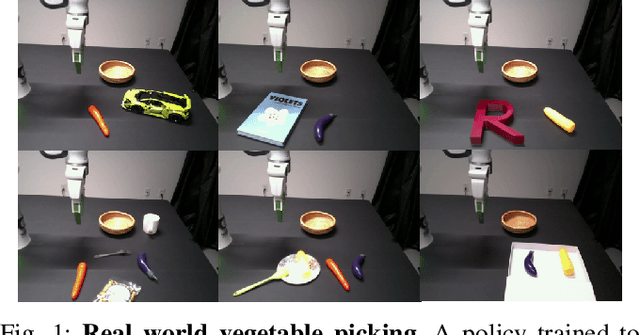
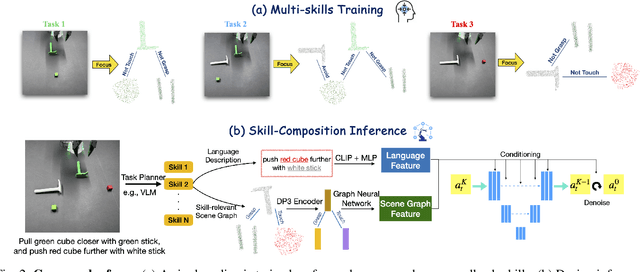
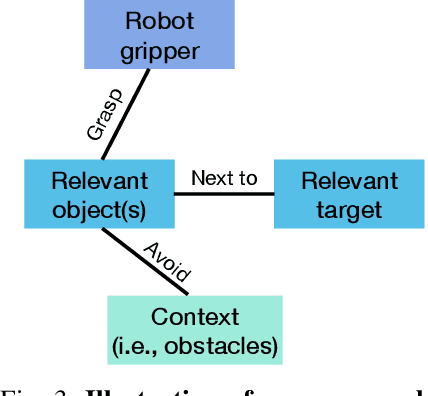
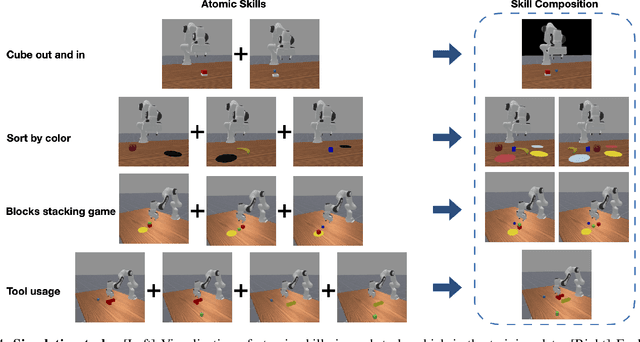
Abstract:A key requirement for generalist robots is compositional generalization - the ability to combine atomic skills to solve complex, long-horizon tasks. While prior work has primarily focused on synthesizing a planner that sequences pre-learned skills, robust execution of the individual skills themselves remains challenging, as visuomotor policies often fail under distribution shifts induced by scene composition. To address this, we introduce a scene graph-based representation that focuses on task-relevant objects and relations, thereby mitigating sensitivity to irrelevant variation. Building on this idea, we develop a scene-graph skill learning framework that integrates graph neural networks with diffusion-based imitation learning, and further combine "focused" scene-graph skills with a vision-language model (VLM) based task planner. Experiments in both simulation and real-world manipulation tasks demonstrate substantially higher success rates than state-of-the-art baselines, highlighting improved robustness and compositional generalization in long-horizon tasks.
MARS2 2025 Challenge on Multimodal Reasoning: Datasets, Methods, Results, Discussion, and Outlook
Sep 17, 2025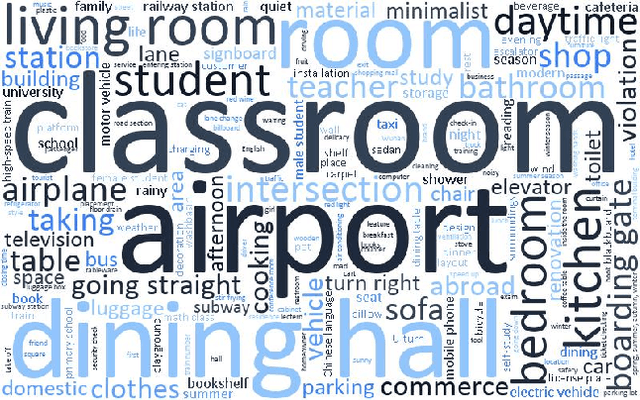
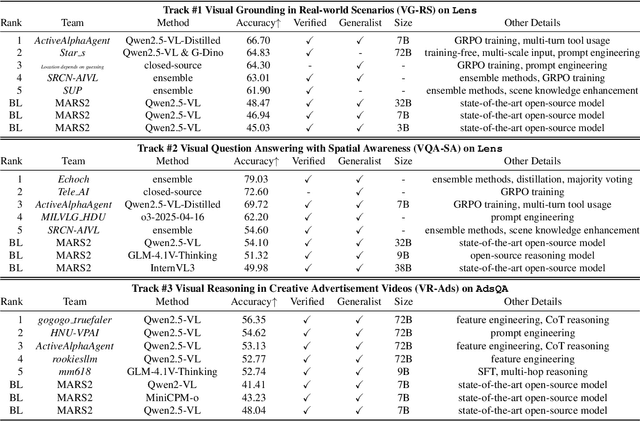
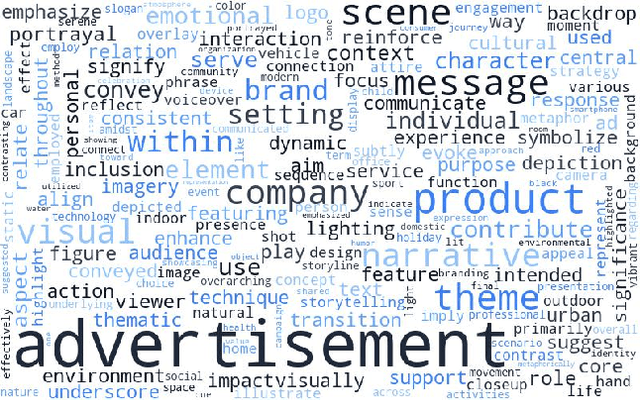

Abstract:This paper reviews the MARS2 2025 Challenge on Multimodal Reasoning. We aim to bring together different approaches in multimodal machine learning and LLMs via a large benchmark. We hope it better allows researchers to follow the state-of-the-art in this very dynamic area. Meanwhile, a growing number of testbeds have boosted the evolution of general-purpose large language models. Thus, this year's MARS2 focuses on real-world and specialized scenarios to broaden the multimodal reasoning applications of MLLMs. Our organizing team released two tailored datasets Lens and AdsQA as test sets, which support general reasoning in 12 daily scenarios and domain-specific reasoning in advertisement videos, respectively. We evaluated 40+ baselines that include both generalist MLLMs and task-specific models, and opened up three competition tracks, i.e., Visual Grounding in Real-world Scenarios (VG-RS), Visual Question Answering with Spatial Awareness (VQA-SA), and Visual Reasoning in Creative Advertisement Videos (VR-Ads). Finally, 76 teams from the renowned academic and industrial institutions have registered and 40+ valid submissions (out of 1200+) have been included in our ranking lists. Our datasets, code sets (40+ baselines and 15+ participants' methods), and rankings are publicly available on the MARS2 workshop website and our GitHub organization page https://github.com/mars2workshop/, where our updates and announcements of upcoming events will be continuously provided.
SafeWork-R1: Coevolving Safety and Intelligence under the AI-45$^{\circ}$ Law
Jul 24, 2025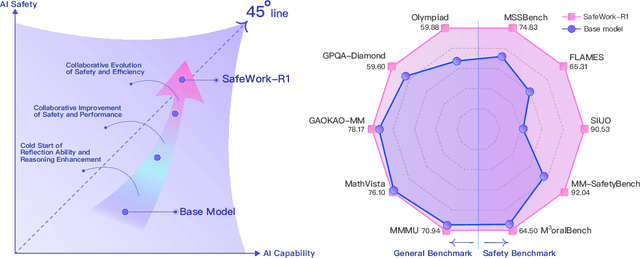
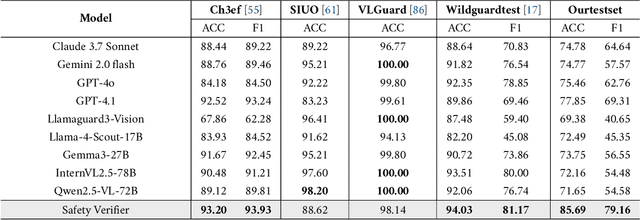
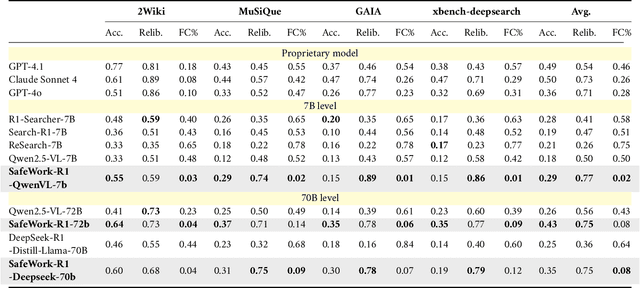

Abstract:We introduce SafeWork-R1, a cutting-edge multimodal reasoning model that demonstrates the coevolution of capabilities and safety. It is developed by our proposed SafeLadder framework, which incorporates large-scale, progressive, safety-oriented reinforcement learning post-training, supported by a suite of multi-principled verifiers. Unlike previous alignment methods such as RLHF that simply learn human preferences, SafeLadder enables SafeWork-R1 to develop intrinsic safety reasoning and self-reflection abilities, giving rise to safety `aha' moments. Notably, SafeWork-R1 achieves an average improvement of $46.54\%$ over its base model Qwen2.5-VL-72B on safety-related benchmarks without compromising general capabilities, and delivers state-of-the-art safety performance compared to leading proprietary models such as GPT-4.1 and Claude Opus 4. To further bolster its reliability, we implement two distinct inference-time intervention methods and a deliberative search mechanism, enforcing step-level verification. Finally, we further develop SafeWork-R1-InternVL3-78B, SafeWork-R1-DeepSeek-70B, and SafeWork-R1-Qwen2.5VL-7B. All resulting models demonstrate that safety and capability can co-evolve synergistically, highlighting the generalizability of our framework in building robust, reliable, and trustworthy general-purpose AI.
Do We Truly Need So Many Samples? Multi-LLM Repeated Sampling Efficiently Scales Test-Time Compute
Apr 02, 2025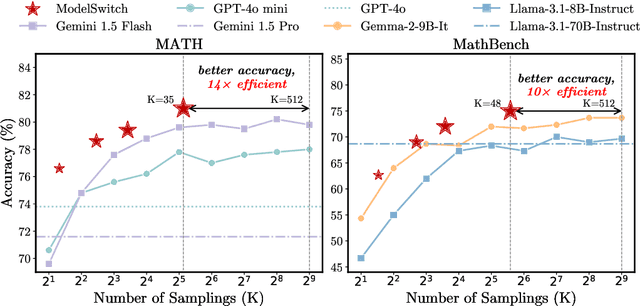

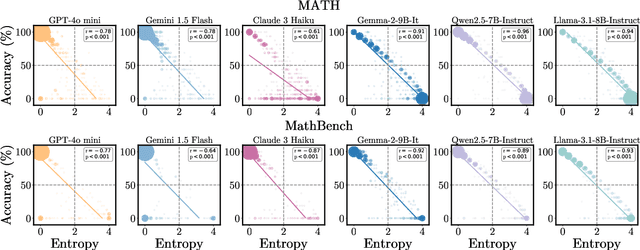
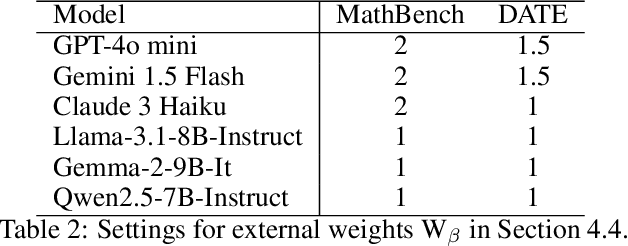
Abstract:This paper presents a simple, effective, and cost-efficient strategy to improve LLM performance by scaling test-time compute. Our strategy builds upon the repeated-sampling-then-voting framework, with a novel twist: incorporating multiple models, even weaker ones, to leverage their complementary strengths that potentially arise from diverse training data and paradigms. By using consistency as a signal, our strategy dynamically switches between models. Theoretical analysis highlights the efficiency and performance advantages of our strategy. Extensive experiments on six datasets demonstrate that our strategy not only outperforms self-consistency and state-of-the-art multi-agent debate approaches, but also significantly reduces inference costs. Additionally, ModelSwitch requires only a few comparable LLMs to achieve optimal performance and can be extended with verification methods, demonstrating the potential of leveraging multiple LLMs in the generation-verification paradigm.
Graph Feedback Bandits on Similar Arms: With and Without Graph Structures
Jan 24, 2025Abstract:In this paper, we study the stochastic multi-armed bandit problem with graph feedback. Motivated by applications in clinical trials and recommendation systems, we assume that two arms are connected if and only if they are similar (i.e., their means are close to each other). We establish a regret lower bound for this problem under the novel feedback structure and introduce two upper confidence bound (UCB)-based algorithms: Double-UCB, which has problem-independent regret upper bounds, and Conservative-UCB, which has problem-dependent upper bounds. Leveraging the similarity structure, we also explore a scenario where the number of arms increases over time (referred to as the \emph{ballooning setting}). Practical applications of this scenario include Q\&A platforms (e.g., Reddit, Stack Overflow, Quora) and product reviews on platforms like Amazon and Flipkart, where answers (or reviews) continuously appear, and the goal is to display the best ones at the top. We extend these two UCB-based algorithms to the ballooning setting. Under mild assumptions, we provide regret upper bounds for both algorithms and discuss their sub-linearity. Furthermore, we propose a new version of the corresponding algorithms that do not rely on prior knowledge of the graph's structural information and provide regret upper bounds. Finally, we conduct experiments to validate the theoretical results.
Projecting Gaussian Ellipsoids While Avoiding Affine Projection Approximation
Nov 14, 2024



Abstract:Recently, 3D Gaussian Splatting has dominated novel-view synthesis with its real-time rendering speed and state-of-the-art rendering quality. However, during the rendering process, the use of the Jacobian of the affine approximation of the projection transformation leads to inevitable errors, resulting in blurriness, artifacts and a lack of scene consistency in the final rendered images. To address this issue, we introduce an ellipsoid-based projection method to calculate the projection of Gaussian ellipsoid onto the image plane, which is the primitive of 3D Gaussian Splatting. As our proposed ellipsoid-based projection method cannot handle Gaussian ellipsoids with camera origins inside them or parts lying below $z=0$ plane in the camera space, we designed a pre-filtering strategy. Experiments over multiple widely adopted benchmark datasets show that our ellipsoid-based projection method can enhance the rendering quality of 3D Gaussian Splatting and its extensions.
Control-oriented Clustering of Visual Latent Representation
Oct 07, 2024



Abstract:We initiate a study of the geometry of the visual representation space -- the information channel from the vision encoder to the action decoder -- in an image-based control pipeline learned from behavior cloning. Inspired by the phenomenon of neural collapse (NC) in image classification, we investigate whether a similar law of clustering emerges in the visual representation space. Since image-based control is a regression task without explicitly defined classes, the central piece of the puzzle lies in determining according to what implicit classes the visual features cluster, if such a law exists. Focusing on image-based planar pushing, we posit the most important role of the visual representation in a control task is to convey a goal to the action decoder. We then classify training samples of expert demonstrations into eight "control-oriented" classes based on (a) the relative pose between the object and the target in the input or (b) the relative pose of the object induced by expert actions in the output, where one class corresponds to one relative pose orthant (REPO). Across four different instantiations of architecture, we report the prevalent emergence of control-oriented clustering in the visual representation space according to the eight REPOs. Beyond empirical observation, we show such a law of clustering can be leveraged as an algorithmic tool to improve test-time performance when training a policy with limited expert demonstrations. Particularly, we pretrain the vision encoder using NC as a regularization to encourage control-oriented clustering of the visual features. Surprisingly, such an NC-pretrained vision encoder, when finetuned end-to-end with the action decoder, boosts the test-time performance by 10% to 35% in the low-data regime. Real-world vision-based planar pushing experiments confirmed the surprising advantage of control-oriented visual representation pretraining.
DMSD-CDFSAR: Distillation from Mixed-Source Domain for Cross-Domain Few-shot Action Recognition
Jul 08, 2024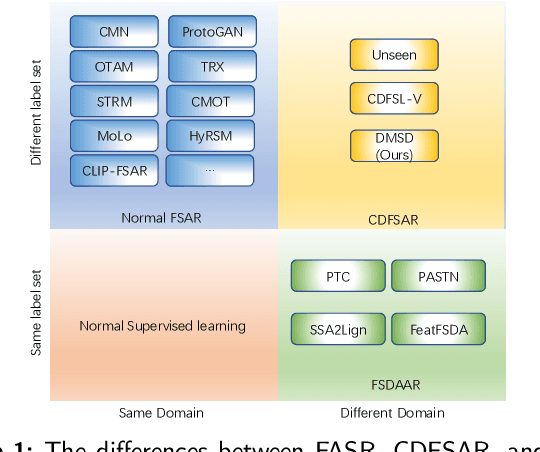

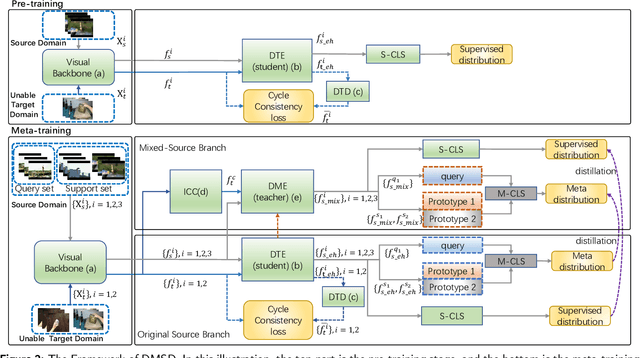

Abstract:Few-shot action recognition is an emerging field in computer vision, primarily focused on meta-learning within the same domain. However, challenges arise in real-world scenario deployment, as gathering extensive labeled data within a specific domain is laborious and time-intensive. Thus, attention shifts towards cross-domain few-shot action recognition, requiring the model to generalize across domains with significant deviations. Therefore, we propose a novel approach, ``Distillation from Mixed-Source Domain", tailored to address this conundrum. Our method strategically integrates insights from both labeled data of the source domain and unlabeled data of the target domain during the training. The ResNet18 is used as the backbone to extract spatial features from the source and target domains. We design two branches for meta-training: the original-source and the mixed-source branches. In the first branch, a Domain Temporal Encoder is employed to capture temporal features for both the source and target domains. Additionally, a Domain Temporal Decoder is employed to reconstruct all extracted features. In the other branch, a Domain Mixed Encoder is used to handle labeled source domain data and unlabeled target domain data, generating mixed-source domain features. We incorporate a pre-training stage before meta-training, featuring a network architecture similar to that of the first branch. Lastly, we introduce a dual distillation mechanism to refine the classification probabilities of source domain features, aligning them with those of mixed-source domain features. This iterative process enriches the insights of the original-source branch with knowledge from the mixed-source branch, thereby enhancing the model's generalization capabilities. Our code is available at URL: \url{https://xxxx/xxxx/xxxx.git}
Graph Feedback Bandits with Similar Arms
May 18, 2024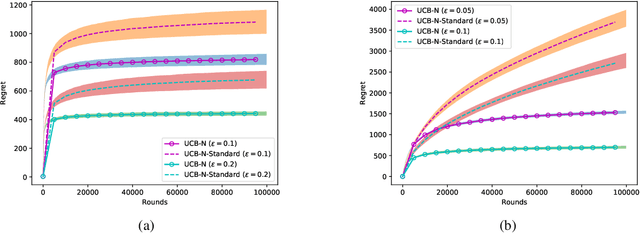
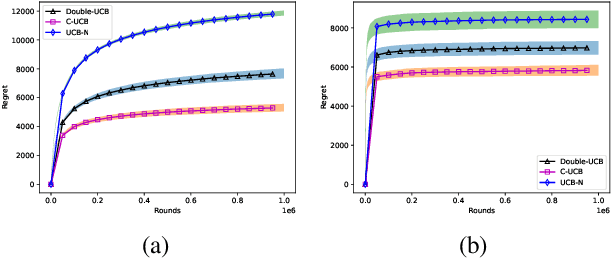

Abstract:In this paper, we study the stochastic multi-armed bandit problem with graph feedback. Motivated by the clinical trials and recommendation problem, we assume that two arms are connected if and only if they are similar (i.e., their means are close enough). We establish a regret lower bound for this novel feedback structure and introduce two UCB-based algorithms: D-UCB with problem-independent regret upper bounds and C-UCB with problem-dependent upper bounds. Leveraging the similarity structure, we also consider the scenario where the number of arms increases over time. Practical applications related to this scenario include Q\&A platforms (Reddit, Stack Overflow, Quora) and product reviews in Amazon and Flipkart. Answers (product reviews) continually appear on the website, and the goal is to display the best answers (product reviews) at the top. When the means of arms are independently generated from some distribution, we provide regret upper bounds for both algorithms and discuss the sub-linearity of bounds in relation to the distribution of means. Finally, we conduct experiments to validate the theoretical results.
CLOSURE: Fast Quantification of Pose Uncertainty Sets
Mar 15, 2024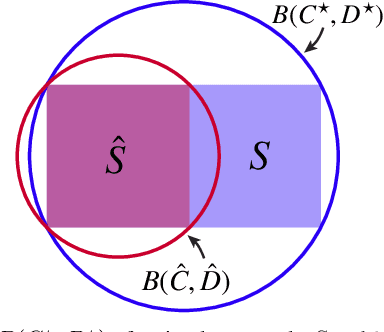
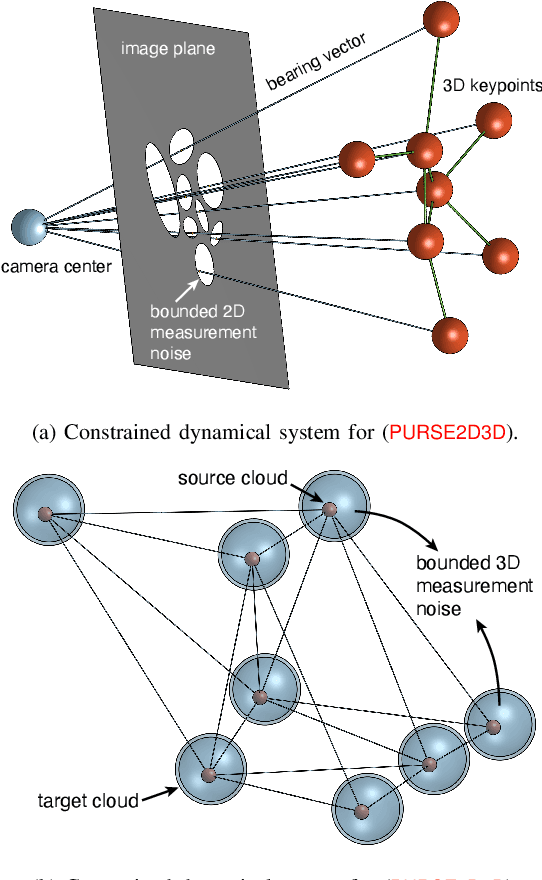
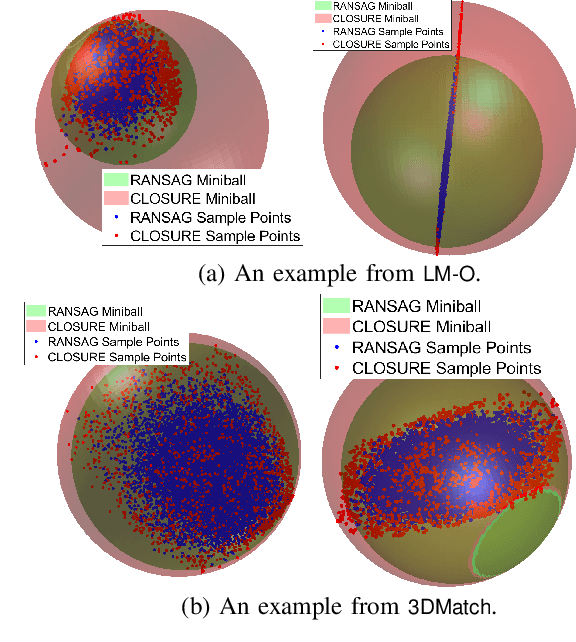
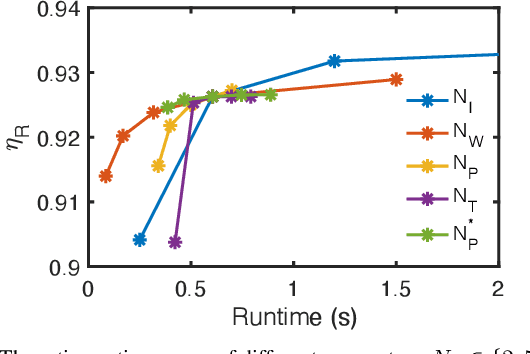
Abstract:We investigate uncertainty quantification of 6D pose estimation from keypoint measurements. Assuming unknown-but-bounded measurement noises, a pose uncertainty set (PURSE) is a subset of SE(3) that contains all possible 6D poses compatible with the measurements. Despite being simple to formulate and its ability to embed uncertainty, the PURSE is difficult to manipulate and interpret due to the many abstract nonconvex polynomial constraints. An appealing simplification of PURSE is to find its minimum enclosing geodesic ball (MEGB), i.e., a point pose estimation with minimum worst-case error bound. We contribute (i) a dynamical system perspective, and (ii) a fast algorithm to inner approximate the MEGB. Particularly, we show the PURSE corresponds to the feasible set of a constrained dynamical system, and this perspective allows us to design an algorithm to densely sample the boundary of the PURSE through strategic random walks. We then use the miniball algorithm to compute the MEGB of PURSE samples, leading to an inner approximation. Our algorithm is named CLOSURE (enClosing baLl frOm purSe boUndaRy samplEs) and it enables computing a certificate of approximation tightness by calculating the relative size ratio between the inner approximation and the outer approximation. Running on a single RTX 3090 GPU, CLOSURE achieves the relative ratio of 92.8% on the LM-O object pose estimation dataset and 91.4% on the 3DMatch point cloud registration dataset with the average runtime less than 0.2 second. Obtaining comparable worst-case error bound but 398x and 833x faster than the outer approximation GRCC, CLOSURE enables uncertainty quantification of 6D pose estimation to be implemented in real-time robot perception applications.
 Add to Chrome
Add to Chrome Add to Firefox
Add to Firefox Add to Edge
Add to Edge